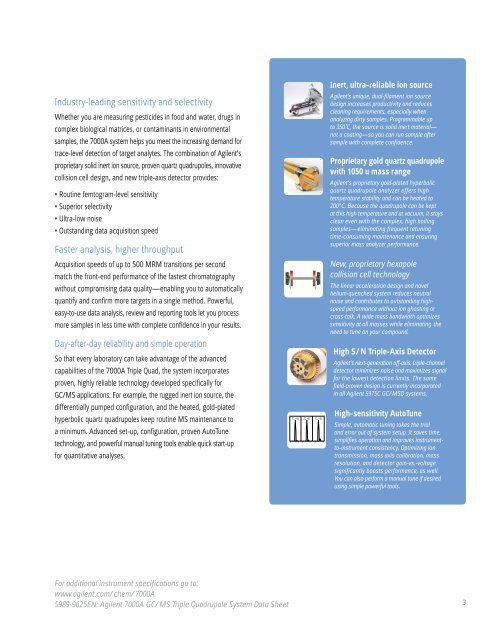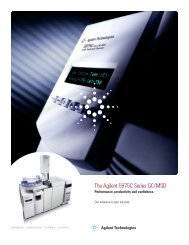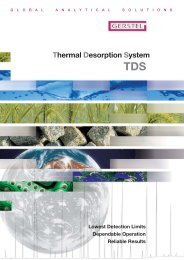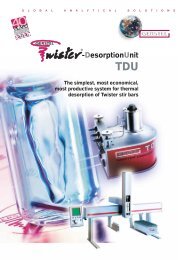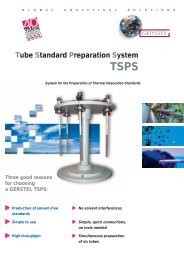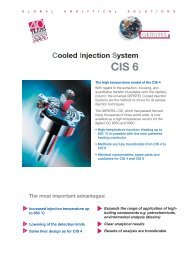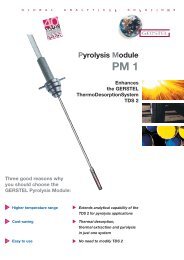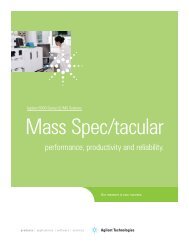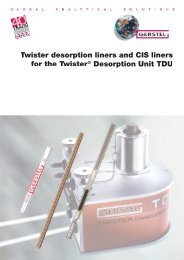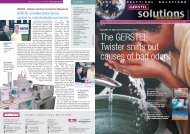Agilent 7000A Triple Quadrupole GC/MS - Research Institute for ...
Agilent 7000A Triple Quadrupole GC/MS - Research Institute for ...
Agilent 7000A Triple Quadrupole GC/MS - Research Institute for ...
You also want an ePaper? Increase the reach of your titles
YUMPU automatically turns print PDFs into web optimized ePapers that Google loves.
Pw50 0.60<br />
Pw50 0.60<br />
Pw50 0.60<br />
66 71 216 221 500 505<br />
Industry-leading sensitivity and selectivity<br />
Whether you are measuring pesticides in food and water, drugs in<br />
complex biological matrices, or contaminants in environmental<br />
samples, the <strong>7000A</strong> system helps you meet the increasing demand <strong>for</strong><br />
trace-level detection of target analytes. The combination of <strong>Agilent</strong>’s<br />
proprietary solid inert ion source, proven quartz quadrupoles, innovative<br />
collision cell design, and new triple-axis detector provides:<br />
• Routine femtogram-level sensitivity<br />
• Superior selectivity<br />
• Ultra-low noise<br />
• Outstanding data acquisition speed<br />
Faster analysis, higher throughput<br />
Acquisition speeds of up to 500 MRM transitions per second<br />
match the front-end per<strong>for</strong>mance of the fastest chromatography<br />
without compromising data quality—enabling you to automatically<br />
quantify and confirm more targets in a single method. Powerful,<br />
easy-to-use data analysis, review and reporting tools let you process<br />
more samples in less time with complete confidence in your results.<br />
Day-after-day reliability and simple operation<br />
So that every laboratory can take advantage of the advanced<br />
capabilities of the <strong>7000A</strong> <strong>Triple</strong> Quad, the system incorporates<br />
proven, highly reliable technology developed specifically <strong>for</strong><br />
<strong>GC</strong>/<strong>MS</strong> applications. For example, the rugged inert ion source, the<br />
differentially pumped configuration, and the heated, gold-plated<br />
hyperbolic quartz quadrupoles keep routine <strong>MS</strong> maintenance to<br />
a minimum. Advanced set-up, configuration, proven AutoTune<br />
technology, and powerful manual tuning tools enable quick start-up<br />
<strong>for</strong> quantitative analyses.<br />
Mass 69.00<br />
ab 426330<br />
Mass 218.00<br />
ab 362315<br />
Mass 502.00<br />
ab 45942<br />
Inert, ultra-reliable ion source<br />
<strong>Agilent</strong>’s unique, dual-filament ion source<br />
design increases productivity and reduces<br />
cleaning requirements, especially when<br />
analyzing dirty samples. Programmable up<br />
to 350˚C, the source is solid inert material—<br />
not a coating—so you can run sample after<br />
sample with complete confidence.<br />
Proprietary gold quartz quadrupole<br />
with 1050 u mass range<br />
<strong>Agilent</strong>’s proprietary gold-plated hyperbolic<br />
quartz quadrupole analyzer offers high<br />
temperature stability and can be heated to<br />
200°C. Because the quadrupole can be kept<br />
at this high temperature and at vacuum, it stays<br />
clean even with the complex, high boiling<br />
samples—eliminating frequent retuning<br />
time-consuming maintenance and ensuring<br />
superior mass analyzer per<strong>for</strong>mance.<br />
New, proprietary hexapole<br />
collision cell technology<br />
The linear acceleration design and novel<br />
helium-quenched system reduces neutral<br />
noise and contributes to outstanding highspeed<br />
per<strong>for</strong>mance without ion ghosting or<br />
cross-talk. A wide mass bandwidth optimizes<br />
sensitivity at all masses while eliminating the<br />
need to tune on your compound.<br />
High S/N <strong>Triple</strong>-Axis Detector<br />
<strong>Agilent</strong>’s next-generation off-axis, triple-channel<br />
detector minimizes noise and maximizes signal<br />
<strong>for</strong> the lowest detection limits. The same<br />
field-proven design is currently incorporated<br />
in all <strong>Agilent</strong> 5975C <strong>GC</strong>/<strong>MS</strong>D systems.<br />
High-sensitivity AutoTune<br />
Simple, automatic tuning takes the trial<br />
and error out of system setup. It saves time,<br />
simplifies operation and improves instrumentto-instrument<br />
consistency. Optimizing ion<br />
transmission, mass axis calibration, mass<br />
resolution, and detector gain-vs.-voltage<br />
significantly boosts per<strong>for</strong>mance, as well.<br />
You can also per<strong>for</strong>m a manual tune if desired<br />
using simple powerful tools.<br />
For additional instrument specifications go to:<br />
www.agilent.com/chem/<strong>7000A</strong><br />
5989-9625EN: <strong>Agilent</strong> <strong>7000A</strong> <strong>GC</strong>/<strong>MS</strong> <strong>Triple</strong> <strong>Quadrupole</strong> System Data Sheet<br />
3


